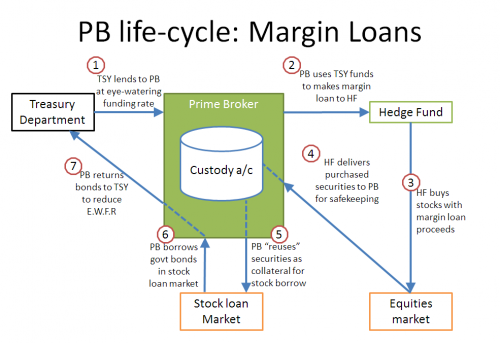Margin lending: Difference between revisions
Amwelladmin (talk | contribs) No edit summary |
Amwelladmin (talk | contribs) m Amwelladmin moved page Margin lending transaction - SFTR Provision to Margin lending over redirect |
(No difference)
| |
Revision as of 10:17, 13 December 2020
|
Prime Brokerage Anatomy™

|
A margin lending transaction is one where one party lends money to another so it can buy or sell securities. The lender will lend up to a certain value of the securities. If the securities fall in value, the lender may ask the borrower to post margin to cover the value of the margin loan.
Usually the borrower lets the lender hold the securities as collateral for the margin loan. The borrower may also allow the lender to use those securities in the market to offset its funding costs of making the margin loan.
This is the classic prime brokerage trade. I’m a hedge fund, and I am all about Vega — the Greek that denotes leverage.[1]
How do I get my spectacular returns? Alpha Leverage, that’s how. I buy securities “on margin”. This means I buy the security, and you, dear prime broker, pay for it.
Well, strictly speaking, you lend me the funds I need so I can pay for it, but in practice, you will be settling the transaction directly with the executing broker and taking delivery of the security on my behalf, under our margin loan. That’s right: in return for lending me the money, you get to “look after” the shares for me, so you can both (i) take security over them to secure the loan, and (ii) reuse those shares — usually using them as collateral when you borrow treasuries in the stock loan market which you can give to your treasury department to offset the funding costs they charged you to to finance the margin loan you made to me in the first place.
I must pay you initial margin as cover should the value of my new asset decline against repayment value of the outstanding margin loan.
The life cycle of a margin loan
The steps, in order, are:
- 1. Treasury funding: The PB borrows from its own treasury department. Business being business, and capital charges being capital charges, this is eye-wateringly expensive for the prime broker.
- 2. Margin loan: Where the client is buying shares outright: The PB lends that money to its hedge fund client in a margin loan to the client can buy some shares. Where the client is taking synthetic exposure to the shares: The PB uses the treasury funds to buy shares for its own book to hedge the synthetic equity swap. This latter case is not, technically a margin loan — it’s an equity swap — but the two are economically identical. So we will treat equity swaps as margin loans for all intents and purposes.
- 3. Share settlement: For cash prime brokerage: The client will direct the prime broker to deliver shares into its custody account with the PB in settlement of the trade. For synthetic prime brokerage: The prime broker settles the shares into its own hedge account. In some markets this may happen by the mysterious process of the equity give-up.
- 4. and 5. Reuse: The PB reuses the shares. For cash prime brokerage: where the client bought the shares outright the PB will “rehypothecate” the shares from the client’s custody account (that is, it will take title to them against a promise to give them back when the client needs them, basically). If it was a hedge to an equity swap, the broker already owned it outright. In either case:
- 6. Collateral upgrade: The prime broker then borrows bonds that meet its treasury department’s exacting standards, using the reused shares from steps 4 and 5 as collateral. The lender of these bonds will often be an agent lender under an agency stock lending arrangement . Once these bonds settle into the prime broker it will...
- 7. Pay down its credit line: Deliver the borrowed bonds back to the treasury department in reduction of the amount it borrowed under step 1.
Easy.
See also
References
- ↑ “My name is Vega. I live on the second floor. I live upstairs from you. Yes, I think you’ve seen me before.” — Suzanne Luca